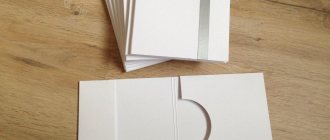Stylish suitcase as a gift with your own hands
Stylish, decorative handmade suitcases are one of the creative ideas that have become popular lately. It is worth noting that such products can replace the dull bags that most girls carry with them. Professional photographers may need a homemade suitcase for photo sessions; this thing can also be very useful in everyday life for storing all sorts of things. What can such a thing be made from?
From cardboard
Cardboard can be used to make a rather cute and roomy accessory - it can be used for various little things, as interior decoration, or as an original gift wrapping. The peculiarity is that in the process we will receive a box. You can use ready-made boxes and simply decorate them.
To work you will need:
- cardboard or cardboard boxes;
- PVA glue;
- masking tape;
- textile;
- laces, ribbons;
- clips or stationery pins.
First of all, we make blanks according to size. You need two large parts in the form of rectangles with rounded corners on one side - this will be the base. The dimensions are as follows: length – 28 cm, width – 15 cm.
You will also need 4 strips of cardboard:
- first: 3 cm wide and 28 cm long;
- second: 8 cm wide, 28 cm long;
- third: 8 cm wide, 58 cm long;
- fourth: 3 cm wide and 28 cm long.
The blanks are cut out. Next, they are connected to each other using tape. A strip 28 cm long is glued to the main rectangular part, and a blank 58 cm long and 8 cm wide is connected to the base and the already glued blank. The result will be the lower part, and the upper part is assembled in the same way.
Now all that remains is to decorate the suitcase. We will use fabric and ribbons. Cut a piece of fabric of the required size and fix it with PVA glue. A free strip of fabric is left on the back wall of the lower part - it will be useful for mounting the upper part and the lid.
The fabric is glued to the lid, then to the bottom. The design also has an internal insert - it is also covered with fabric and glued inside. The top edge of this part should protrude slightly beyond the side.
You need to glue tapes on the sides - they will act as limiters, thereby preventing the lid from opening too much.
Then two cardboard parts are glued to the base - these are bottom and lid reinforcements. They are also covered with woven materials. All that remains is to decorate the upper part of the structure. To do this, use foam rubber or other soft filler. Cut to shape and glue to the lid.
This is how you can easily make a suitcase with your own hands from cardboard, fabric and glue. The result will be excellent gift wrapping or a craft case.
On video: how to make a suitcase box as a gift with your own hands.
Wooden accessory
This master class will tell you how to make a suitcase out of wood. The result is more of a case - it is used at home for various things. The work does not require rare or hard-to-find materials; everything you need is either already there or can be easily bought in a store.
The frame is easy to make from wood - the base will be a sheet of plywood, and the side walls will be made of bars. The frame is glued with glue and then reinforced with self-tapping screws. Next, the entire structure is carefully polished.
For decoration, the author used dermantine of the desired color. The material is marked exactly according to the size of each sash, taking into account the gates. The frame, sparing no glue, is coated completely and the material is laid on it.
Then the dermantine is smoothed out - it is better to do this from the center to the edges. If air bubbles appear, they are expelled with a roller or squeegee. The dermantine should lie very tightly on the wooden base.
Particular attention should be paid to corners and edges - the material should stick well in these places. To ensure that the dermantine lays perfectly, it is recommended to iron it through a thick fabric.
Next, install the fittings. It's good to use what's left of an old suitcase. The main thing is that the fittings are beautiful and reliable.
DIY suitcase
Author: Natalya June 05, 2013 at 10:27 am in the section Master classes
Making a suitcase with your own hands, as it turns out, is very simple. Much easier than restoring an old suitcase. This does not require any “preserved” elements and devices, and all the necessary materials are available and sold in stores at fairly low prices.
Background
As often happens in creative practice, the necessary things are usually found in the trash, like our Soviet-era suitcase, slightly larger than a briefcase. Its dimensions were suitable for storing a bunch of jewelry and trinkets, woven, but lying around idle. The very shabby, dirty and unaesthetic appearance of a useful household item left no doubt: restoration of the old suitcase was necessary.
First, the fittings were carefully removed and placed to soak in a jar of gasoline. Then the linings and ancient torn dermantine were removed. Then it turned out that the side boards making up the frame were rotten, and the walls of the lids were generally made of thick cardboard, punched to huge holes in several places.
The cardboard was torn off and thrown away. Instead, boards of the required size were cut from hardboard. The wooden frame was sanded down to white wood, a couple of walls were replaced with new ones and reinforced with glue and screws. The hardboard covers are glued on and nailed down.
So, we can say that we started constructing a suitcase with our own hands almost from scratch.
Exterior finishing
Dark brown dermantin was used for finishing. The dermantine is marked strictly according to the dimensions of each flap of the suitcase, taking into account the folding on the walls of the inner sides.
Carefully cover the surface of the dermantine with PVA glue, and, accordingly, one of the lids of the suitcase. We glue the material, carefully expelling all air bubbles and excess adhesive liquid, smoothing out any irregularities. We have a felt squeegee for this purpose.
We especially conscientiously roll the material along the perimeter of the edges so that the suitcase made by hand looks aesthetically pleasing, as if it came out of a factory assembly line yesterday.
The hardest part is gluing the corners. We deliberately do not provide patterns, because we assume that every home craftsman has his own vision of the technology for high-quality finishing of corners when restoring an old suitcase. The main thing here is precision, a lot of glue and diligence.
We will show a number of photographs that, we hope, will help clarify the technological process of gluing corners.
When the dermantine is stretched onto the frame, it is recommended to walk over the set glue with a warm iron to secure (bake) the gluing. Be sure to iron with a cloth, otherwise your synthetic material will melt.
At this point, we consider the first stage of making a suitcase with our own hands, or restoring an old one, complete. Therefore, we will put back his fittings.
Internal upholstery
For the interior upholstery, we will make pads on padding polyester, covered with synthetic velvet, or any other suitable textile. The illustration shows the components of “velvet” pillows and part of the procedure for their layer-by-layer formation.
When the pillows are ready, coat the inner walls of the product with glue and glue it inside the pillow.
This is what our “new” handmade suitcase looks like.
We did not attach the handle. The project is to make our suitcase worn on a shoulder strap, like a sketchbook, but there is no time yet to look for suitable fittings and options for attaching them.
So, we have created a functional item, the practical applicability of which is not limited to storing jewelry or tools. The master class not only clearly shows how to make a suitcase with your own hands, but also comes in handy as instructions on how to restore an old suitcase.
Materials and tools used in the master class:
- skeleton of a suitcase with accessories;
- sandpaper, hammer, screwdriver, brush, scissors, mounting knife;
- hardboard and wooden slats (optional);
- PVA glue;
- shoe nails 10 mm long;
- dermantin, cardboard, padding polyester, synthetic velvet.
Time spent on restoration:
- giving the product a look suitable for finishing, including sanding and puttying - 2-3 days;
- finishing - 2-3 hours.
Tag:
Modern tool box
If we use an organizer to store business papers and documents in everyday life, then the tool needs its own case - a special tool box. You can divide tool boxes into professional and universal, which are most often used in the household.
Our grandfathers generally made a toolbox with their own hands, but today there is no need for this - you can always find what you need on sale at a very reasonable price. Naturally, those who like to do everything with their own hands still have the right to express themselves here and assemble an original case that meets all individual requirements.
Professional boxes are generally made for specific sets of tools, which depend on the type of activity.
Homemade designs
It is impossible to unequivocally answer the question: how to make a tool box with your own hands, since there are a huge number of options, unlimited by anything except your imagination. I would like to note that you can use old paper cases, bags, or make a complete box yourself. The material used is metal or wood.
Internal partitions are also made of wood or plastic. The lids are hung on hinges; it is necessary to provide a lock that will protect against accidental opening.
The finished box is painted or sheathed with available and suitable material, both outside and inside.
Not obvious aspects of choice
In the selection process, first of all, look at the material from which the case is made.
Plastic tool boxes are lightweight and easy to use and repair. Despite all this, they do not withstand mechanical stress and loads very well.
Stronger and more durable metal tool boxes made from aluminum, its alloys or steel. With greater weight, they are more durable, but require periodic maintenance: restoration of paintwork, cleaning of rust and traces of corrosion. Among other things, metal boxes are more expensive.
If you need to transport bulky and heavy tools, it is better if it is a tool box on wheels.
Homemade structures most often consist of a wooden tool box. Main disadvantages: bulky, heavy weight. At the same time, wooden structures have a specific advantage, namely: wood stores metal tools well, since it absorbs moisture from the surrounding space.
Keep practicality in mind: the drawer should provide easy access to all tools. It must have a fairly reliable case that protects the contents from moisture, dust and external influences.
It’s not always convenient when there are too many compartments and drawers inside: you can get confused in them and spend a long time looking for what you need.
Pay attention to the hinges and lock - as practice shows, these are the elements that most often break.
I cut my own cases in several passes, I decided to cut them because it turns out to be much cheaper, + it turns out to be much more accurate and of better quality - after all, you do it for yourself!
LiveInternetLiveInternet
This master class was born out of the need to house an ever-growing supply of hamsters.
The task was this: you need a lot of storage containers with minimal costs! And the choice fell on ordinary boring boxes, which I dressed up a little.
For work we will need:
- Actually the box (I have it from shoes)
- Old wallpaper (found in the attic at the dacha) for finishing, and some scrap paper (if there is no wallpaper)
- Fabric for interior decoration (I have scraps and all sorts of leftovers)
- Straps from old bags
- Leatherette or leather (for corners)
- Various decor (at your discretion, I used my old unnecessary embroidery)
- Glue
- Ruler
- Scissors
- Pencil
- Cardboard
- Needle with thread
- Awl
- Paper
This is what our “blank” looks like from the outside.
And inside.
I didn't cut off the lid, I left it as is.
The first thing you need to do is cover the ends of the lid with scraps of paper (wallpaper, scrap paper) with folds inward and onto the lid itself.
Since I mostly have scraps, I selected them by size.
But if there are large pieces, you can think through and plan everything first.
It was more interesting for me to glue it impromptu.
I selected the pieces for the lid itself, glued them without bends, with a slight overlap (2-3 mm) on each other.
We continue to glue the sides of our box around the perimeter, folding the paper to the bottom and inward.
To hide all the ends of the box.
This is what the box looks like upside down.
We measure the size of the bottom and cut out a solid piece of wallpaper 1-2 mm smaller.
It is better not to glue pieces of paper to the bottom, because over time they will come off.
This is what the box looks like from all sides:
Now let's start decorating.
Let's style our box as a vintage suitcase.
To do this, we will need belts from bags and old keys (if you don’t have belts of a suitable color, you can take any other color and paint it with acrylic paint).
We insert the straps into the keys as shown in the photo and sew them with strong thread.
Then we glue the straps with keys around the box, imitating the straps of a suitcase.
It should look like this. I had one belt that was enough for exactly two parts.
For additional fastening and decoration of the belts, I prepared very old “brads” - army stars, which I inserted into equally old buttons.
We mark with a ruler the place where we will attach our brads and pierce holes with an awl.
Our stars are securely fastened (view from the inside of the lid).
And from the outside.
To prevent our suitcase from fraying ahead of time, we need to make corners for it.
To do this, take paper, a ruler with circles and a pencil.
Draw a circle of suitable diameter and cut it out, as in the photo below.
This is a template according to which we will make corners from leather or faux leather (whoever has what).
A total of 8 corners are needed.
Then we glue the corners to the corners of the suitcase, as shown in the photo.
They will protect the paper from being erased during use.
Initially I didn’t think about it, but in the process I decided to make a handle for the suitcase.
We sew it from belts and metal fittings from an old bag
We fasten the handle in place first with glue, then additionally with brads.
Now that the external work is over, let’s move on to the inside of our suitcase.
And this is what it looks like inside.
Here you will need fabric, cardboard (my unnecessary first embroideries for decoration).
We measure all the inner walls of the box, the bottom and the lid and cut them out of cardboard.
From the fabric parts we cut out a couple of centimeters more than the cardboard parts for bending.
I started with the lid.
I selected the embroidery to size, cut out the cardboard and covered it with fabric with embroidery.
I wrapped the edges of the fabric behind the cardboard and glued it on.
This is what the reverse side looks like:
Glue the piece in place:
In the same way we glue the bottom and side walls.
I stopped there for now, because I have not yet decided what exactly I will store there.
You can also make a variety of partitions for storing small items.
Or sew on different pockets for convenience. (This must be done before gluing the cardboard to the box).
In any case, the box for storing what you need is ready!
If desired, the edges of the suitcase can be tinted, aged or painted.
I like it this way because everything that was used in the work for me has a story.
Every detail reminds of something, especially the wallpaper - you begin to remember when and where they were pasted, how old you were and other nostalgia)
By the way, I would like to add that in such a suitcase you can store not only your creative materials, but also old photographs, memorabilia, or a collection of postcards (like mine).
One suitcase seemed to me not enough, and I went further in search of boxes.
Moreover, there is a lot of wallpaper left)
Using the same principle, I made another box.
And one more...
And one more...
And all together they look like this.
I didn’t specially make decorations on the lids so that they could be stacked on top of each other in a pyramid.
Or hide the smaller one in the larger one - like nesting dolls!
All that remains is to fill everything in and enjoy aesthetic pleasure and ease of storage.
Thanks everyone for your attention!
Source








